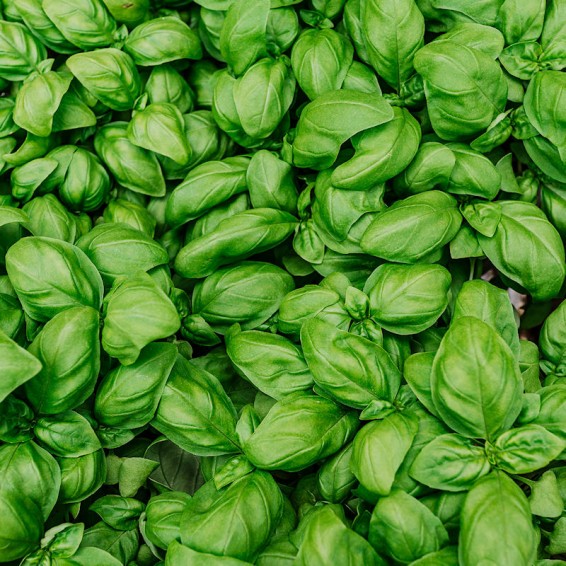Organic Italian Large Leaf Basil Seeds
- HOW TO GROW
- FAST FACTS
- REVIEWS
HOW TO GROW
Sowing: Since basil thrives in warm weather, it grows best when the soil has warmed and there is no chance of frost. Gardeners with short growing seasons may want to start their seeds indoors 3-4 weeks before the last frost date, sowing them thinly in flats and providing heat to speed germination. Transplant 15-18" apart. To direct sow, plant the seeds 1/4" deep in rich soil and full sun, thinning to 15-18" apart when the seedlings develop. Basil also grows well indoors or as a container plant.
Growing: Basil thrives in soil that drains well, yet needs water often. If the weather drops below 50 degrees, provide protection. As the plant grows, pruning it helps it to develop into a bushy, healthy plant; pruning is also important because once the plant flowers, it will begin to wilt and die. To prune the plant, remove the top several sets of leaves on each stem, taking care to leave at least three sets of leaves on the lower part.
Harvesting: Basil leaves can be harvested as soon as they reach a height of 6-8". The best time to harvest the leaves is in the morning after the dew dries. After the plant is established, harvesting often actually improves production; once the flowers develop, however, the leaves grow bitter to the taste. Remove single leaves or parts of a stem as needed, taking care to leave at least three sets of leaves on the length of the stem for healthy growth. When harvesting, pinch off the stem directly above the next set of leaves. Fresh basil will keep for several days at room temperature, with the stems in a glass of water; if refrigerated, it tends to wilt and turn brown. Basil also freezes and dries well. Since the water content of basil is very high and it can mold easily, the best method for drying is a dehydrator, an oven, or a similar dry, warm location.
Seed Saving: After the flowers have finished blooming, the seeds will begin to develop. Harvest the clusters of pods when they turn brown, and spread them out to dry in a protected location away from direct sunlight. Thresh the heads to remove the seed, and clean out as much of the chaff as possible. Store the seeds in a cool, dry place.
FAST FACTS
Latin Name: Ocimum basilicum
Type: Open Pollinated, Heirloom, Warm Season
Life Cycle: Annual
USDA Zones: 3, 4, 5, 6, 7, 8, 9, 10, 11, 12
Seeds per Ounce: 21,100
Planting Method: From Transplant
Sunlight: Full Sun
Height: 30 Inches
Color: Green
Bloom Season: Blooms Late Summer, Blooms Early Fall
Uses: Aromatic
Great Product
Great product, The seeds were delivered quickly to my house, and I was able to get them planted quickly, the package tells you everything you need to know.
DESCRIPTION
HOW TO GROW
Sowing: Since basil thrives in warm weather, it grows best when the soil has warmed and there is no chance of frost. Gardeners with short growing seasons may want to start their seeds indoors 3-4 weeks before the last frost date, sowing them thinly in flats and providing heat to speed germination. Transplant 15-18" apart. To direct sow, plant the seeds 1/4" deep in rich soil and full sun, thinning to 15-18" apart when the seedlings develop. Basil also grows well indoors or as a container plant.
Growing: Basil thrives in soil that drains well, yet needs water often. If the weather drops below 50 degrees, provide protection. As the plant grows, pruning it helps it to develop into a bushy, healthy plant; pruning is also important because once the plant flowers, it will begin to wilt and die. To prune the plant, remove the top several sets of leaves on each stem, taking care to leave at least three sets of leaves on the lower part.
Harvesting: Basil leaves can be harvested as soon as they reach a height of 6-8". The best time to harvest the leaves is in the morning after the dew dries. After the plant is established, harvesting often actually improves production; once the flowers develop, however, the leaves grow bitter to the taste. Remove single leaves or parts of a stem as needed, taking care to leave at least three sets of leaves on the length of the stem for healthy growth. When harvesting, pinch off the stem directly above the next set of leaves. Fresh basil will keep for several days at room temperature, with the stems in a glass of water; if refrigerated, it tends to wilt and turn brown. Basil also freezes and dries well. Since the water content of basil is very high and it can mold easily, the best method for drying is a dehydrator, an oven, or a similar dry, warm location.
Seed Saving: After the flowers have finished blooming, the seeds will begin to develop. Harvest the clusters of pods when they turn brown, and spread them out to dry in a protected location away from direct sunlight. Thresh the heads to remove the seed, and clean out as much of the chaff as possible. Store the seeds in a cool, dry place.
FAST FACTS
Latin Name: Ocimum basilicum
Type: Open Pollinated, Heirloom, Warm Season
Life Cycle: Annual
USDA Zones: 3, 4, 5, 6, 7, 8, 9, 10, 11, 12
Seeds per Ounce: 21,100
Planting Method: From Transplant
Sunlight: Full Sun
Height: 30 Inches
Color: Green
Bloom Season: Blooms Late Summer, Blooms Early Fall
Uses: Aromatic
Reviews
Review
Great Product
Great product, The seeds were delivered quickly to my house, and I was able to get them planted quickly, the package tells you everything you need to know.





